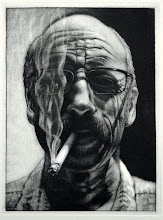There are a number of reasons to develop a series of drawings based on a single theme. Perhaps the most basic is that art involves the mind as well as the coordination between eyes and hand. Art sometimes begins with an exercise in thinking and moves to an exercise in doing. Each of you are probably at the point where your thinking is about to become your doing. But it can also reverse and the doing can lead to the thinking, but the process of thinking, observing, and executing drawings are always in tandem. Your thematic series will allow you to go into your own work more deeply, with more involvement and greater concentration. You're also working more independently, setting your own pace.
The process of working on a series develops a commitment to your ideas fostering a professional approach. And as you develop that professional attitude, you will begin to notice the thematic patterns in other artists' work. Let's say that you're series will be based on landscape, what other artists have shared that theme with you? Look at the work of contemporary landscape artists such as April Gornik, Peter Doig, Scott Goudie, Neil Welliver, chuck Forsman, and Susan Puetz. How about portraits? Look at contemporary artists such as Sylvia Sleigh, Richard Avedon, Robert Weaver, Duane Hanson, Cindy Sherman, or Everett Kinstler.
Eva Hess said, "If something is meaningful, maybe it's more meaningful said ten times."

Im was having trouble deciding the scale to make my drawing because it takes me so long to complete one. I also didn't know which media to because I wasnt sure if i would have to stick with it through the whole series.. it will be a challenging assignment...
ReplyDeleteYou probably have a pretty good sense of what you're able to accomplish in a given amount of time, so use that measurement to help determine your scale. Keep in mind, though, that the smaller the scale the tighter the image. Look at those cloud drawings again, they are almost to scale as the reproductions on the handout. That detail is phenomenal. As far as the medium/media, go with whatever you feel most confident using and by the time you finish the series, you'll have a much better grasp of that material.
ReplyDelete